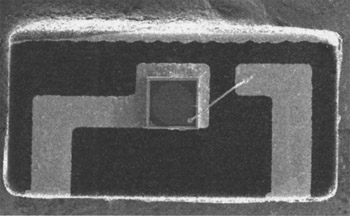4 The INDEED solution
4 The INDEED solution
The INDEED solution is a cellular-type hybrid line-of-sight link (Figure 16.1, ‘ ).
4.1 Downstream transmitter
The downstream light sources are 1550 nm Fabry-Perot cavity semiconductor laser diodes (-FP-LDs). Each cell transmitter contains three diodes and one-diode optical output power is 8 mW.
Their essential characteristics and specifications are:
-
Several longitudinal modes around 1550 nm and a low degree of coherence to avoid speckle problems at the output of optical multimode fibre divergent adaptors.
-
The resonance frequency must be higher than 1 GHz to avoid excess relative intensity noise and limits of the modulation frequency.
-
The emitting area is approximately 1 to 2 ¼ m 2 and its radiation pattern opens up to 40 °.
4.2 Receiver
The photo-detector is a semiconductor PIN-hetero-junction photodiode. The semiconductor is a III-V compound: InGaAs/InP. The active area is 0.2 mm 2 (Figure 16.5).

Figure 16.5: The InGaAs/InP photodiode
The OOK modulated signal, coded in NRZ (No Return to Zero), is then amplified and processed to obtain a minimum detectable power (or sensitivity) of ˆ’ 40 dBm (100 nW) at 155 Mbit/s at 10 ˆ’ 9 BER.
Typically, a concentrator [Kahn, 1997; Street, 1997] is used, with a 1550 nm selective filter. The presence of a lens (light energy concentrator) justifies itself especially in directive systems where the concentration bonus is inversely proportional to numerical aperture of receiver (FOV-Rx) [Street, 1997]. As diffuse systems, the gain in power can however reach 3 dB with sources approaching 900 nm [Kahn, 1997].

Figure 16.6: The transmitter-receiver LOS hybrid INDEED point to point link
The INDEED photo-receiver unit is very different from the devices tailored ( custom-designed ) for optical fiber applications:
-
The photodiode is a "large sensitive area" component to collect the highest number of photons . Therefore, the parasitic "function+metallisation" capacitance is much higher. The structure of the low signal-low noise transimpedance amplifiers need to be revised.
-
The photodiode is exposed to ambient radiation and must be protected and shielded .
-
The noise sources are due to:
-
Shot noise, noise due to random nature of light emission and thus detection, associated with exit current at darkness (photons generation and recombination),
-
Scintillation noise due to random movements of junction mobile charges,
-
Detector thermal noise ( Background Limited Infrared Photodetector BLIP, detector very sensitive to IR and the obscurity noise which is essentially due to photons issued from ambient radiation).
-
Surface effects noise, as the consequence of capture and release of mobile charges.
-
EAN: 2147483647
Pages: 191